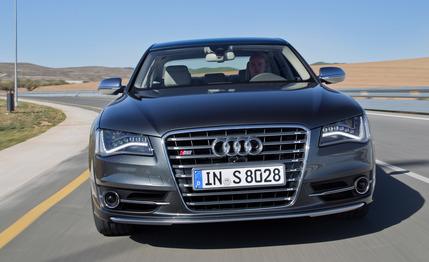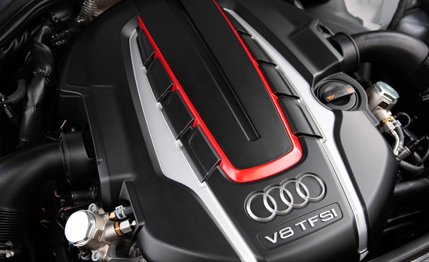
 First Drive Review
First Drive Review
The Audi S8 is built with the North American market in mind: 30 percent of total production is sold here. But was the car engineered for this market or for the autobahn? After two days behind the wheel, it seems that the answer is both.
The new Audi A8 is a behemoth, meaning the S8, even though it is available only with a short wheelbase, is also huge. An aluminum-intensive body and structure help keep weight to about 4400 pounds, a little bit heavier than the Jaguar XJ Supersport but 600 or so pounds lighter than the Mercedes-Benz S63 AMG.
The last S8 was powered by a high-revving, naturally aspirated, 5.2-liter V-10, an engine that seemed somewhat out of place in a luxury sedan. This one is propelled by a 4.0-liter V-8 force-fed by two IHI turbochargers. This powerplant may be smaller, but it is far more powerful—520 hp versus the previous model’s 450—and has tremendous torque: 479 lb-ft, available from 1700 to 5500 rpm, compared with 398 in the last car. This is great news for the S8’s straight-line performance. It should need only four seconds to go from 0 to 60 mph, an improvement of more than a full second over the previous generation. Top speed again is governed at 155 mph. Under throttle, the S8 emits a delicate growl that grows in volume and urgency as the redline nears, but it is never loud. Speed compounds so quickly and discreetly that lengthy and costly roadside lectures from authority figures—like the one we encountered while driving the S8 in provincial Spain—seem almost inevitable.


In addition to cutting cylinder count and reducing displacement, Audi fitted the 2013 S8’s engine with cylinder deactivation. Thanks to active engine mounts that dampen unwanted vibrations and a noise-cancellation system that uses the car’s stereo, we never felt the switch from four- to eight-cylinder operation. Power is delivered to all four wheels through a ZF eight-speed automatic. Even though you can play with the transmission a bit with the paddles on the steering column, we predict most drivers will give up sooner or later and leave the work to the slushbox.
Although there’s a 40/60-percent front-to-rear torque split and you can steer the S8 with the gas pedal on loose gravel, it would be a mistake to confuse this 4400-pounder with a sports car. On tarmac, understeer is the order of the day. Moreover, there is considerable body roll. The “drive select” system, which allows you to modify throttle response, damper stiffness, steering weight, and exhaust sound, includes a dynamic setting, but we wish it were far more dynamic. As it is, we found the sporty mode to be too similar to the comfort and auto settings. Granted, the (heavier) S63 exhibits similar limitations, but we expected the Audi to be far better.
Like most of Audi’s performance derivatives, the S8’s styling is only subtly differentiated from the regular A8’s. The most obvious changes are the standard 20-inch wheels—21s are available—the aluminum mirror caps, and the grille detailing. The lower air intakes are modified, and the exhaust exits the car through four tailpipes instead of two. U.S. pricing is not yet finalized, but expect a sticker north of $100,000.
As a fast, capable executive rocket, the S8 absolutely satisfies. But if you’re looking for a size-XL sports sedan, the Jaguar XJ Supersport or the Porsche Panamera Turbo might be more your (cornering) speed.

